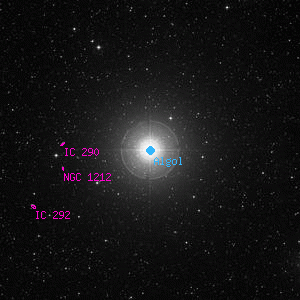Algol

Overlaid DSS image of Algol, 60' x 60' with north at top and west to the right
Aladin viewer for the region around Algol
Beta Persei, β Per, 26 Per
BD+40 673, HD 19356, HR 936, WDS J03082+4057, SAO 38592, HIP 14576
BD+40 673, HD 19356, HR 936, WDS J03082+4057, SAO 38592, HIP 14576
| Type | Star |
|---|---|
| Magnitude | 2.12 | Right Ascension | 3h 8' 10.1" (2000) |
| Declination | 40° 57' 20" N |
| Constellation | Perseus |
| Classification | B8V |
Observing Notes
Captain William Henry Smyth
Aug 18, 1835 No. 6 The Crescent, Bedford, England (map)
150mm f/17.6 refractor by Tully 1827
A variable star, in the forehead of the larva of Medusa, with a companion in the sp quadrant, and two others np. A 2 to 4, whitish; B 11, purple. This star is generally known as Algol, a variation of Al-ghúl, the monster or demon; so harshly depicted in Hevelius's map of this asterism. This ominous name was mightily noted in Astrology, and to its influence poor Padre Vitalis, in his dismal Jeremiad, attributed the then unhappy lot of the kingdom of Naples. Dr. Sedillot writes rhûl for ghúl, but he adopted so singular a mode of expressing Arabic words, that it is not always easy to find out what he meant to denote.
Algol is the most remarkable of the periodic stars, since the increase and decrease in its changes of light occupy but seven or eight hours; and this is best observed at the recurrence of the diminished light, because when brightest it is the more difficult to determine, from its varying in brilliance at different times. The most feeble light lasts about eighteen minutes, from the examination of which, Argelander concludes that the period of Algol is not quite constant. The first who observed these variations was Montanari; and in 1694 Maraldi ascertained that it changed from the 2nd to the 4th magnitude. The period has been thus determined:ByWurm 2d 20h 48m 58s.7It varies from the 2nd to the 4th size in three hours and a half, and back again to the 2nd in the same time, and so remains for the rest of the period, retaining its brightness. These singular appearances are accounted for, by supposing the body to revolve on an axis, having parts of its surface not luminous; and ♅. observes that such stars, besides a rotatory motion on their axes, may also have other movements—"Such as nutations or changes in the inclination of their axes; which added to bodies much flattened by quick rotatory motions, or surrounded by rings like Saturn, will easily account for many new phenomena that may offer themselves to our extended views."
By Goodricke 2d 20h 48m 56s.0
To find Algol by alignment, project a ray from Orion's belt through Aldebaran, and carrying it something more than double the distance, it will hit the head of Medusa; or, lisping in numbers,Thus belt of Hero, eye of Bull,These same stars collectively, were formerly called the Gorgons, the præses of which has had a movement in space attributed to it, to the following amount:
so surely mark the place
Where Algol shines, 'bove three faint stars,
in fell Medusa's face.
P.... RA +O".ll Dec. -0".04
B.... +0".03 +0".02
[Hipparcos +0".00299 -0".00166]― A Cycle of Celestial Objects Vol II, The Bedford Catalogue, William Henry Smyth, 1844
Other Data Sources for Algol
Nearby objects for Algol
Credits...
Drawings, descriptions, and CCD photos are copyright Andrew Cooper unless otherwise noted, no usage without permission.
A complete list of credits and sources can be found on the about page
Algol